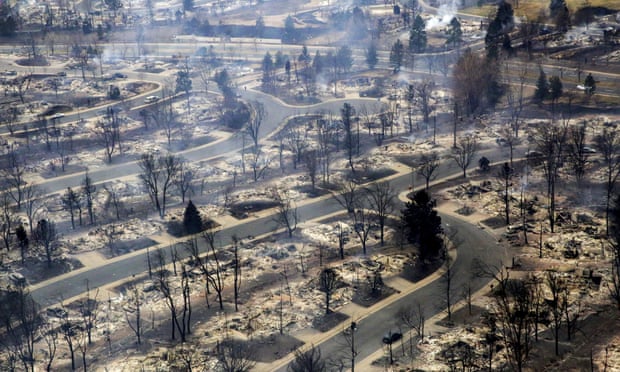Three people are missing and feared dead after a wind-stoked wildfire roared through two towns in Boulder county, Colorado, prompting thousands of evacuations and destroying nearly 1,000 homes, authorities said on Saturday, AzVision.az reports citing the Guardian.
Officials initially said there were no reports of fatalities or missing residents following the rare urban wildfire that erupted Thursday morning on the northern outskirts of the Denver metropolitan area.
Wind gusts of more than 100mph (160km/h) pushed flames eastward into the towns of Superior and Louisville, prompting the evacuation of both communities. In about two hours, the fire had scorched 6,000 acres (2,400 hectares), officials said.
Boulder county sheriff Joe Pelle said the three missing people, whom he declined to identify, all lived in homes that were consumed by the blaze.
“The structures where these folks would be are completely destroyed and covered with about eight inches (20cm) of snow,” Pelle said at a Saturday news briefing, adding cadaver dogs will be deployed on Sunday to search the dwellings.
Pelle said 991 homes in Superior, Louisville and in unincorporated parts of the county have been destroyed, making it the most destructive wildfire in state history in terms of residences lost.
Officials initially said sparks from downed power lines that were toppled by the gale-force winds may have sparked the blaze, but an inspection by utility company Xcel Energy found no damaged or downed lines near the fire’s suspected origin.
Pelle said detectives were investigating all avenues to determine the source of ignition. Acting on a tip, the sheriff said a search warrant was issued in connection to the probe, but declined to offer any details.
Joe Biden declared the situation a disaster and experts warned that the climate crisis and suburban expansion contributed to the devastation.
Hundreds of residents who had expected to ring in 2022 in their homes were instead on Saturday starting off the new year trying to salvage what remained of them.
Families who had been forced to flee the flames with little warning returned to their neighborhoods Friday in Louisville and Superior, which have a combined population of 34,000, north of the state capital Denver, to find a patchwork of devastation.
At least seven people were reported to be injured.
Many homeowners on Saturday were already talking about building back in the same place.
Advertisement
Cathy Glaab found that her home in Superior had been turned into a pile of charred and twisted debris, one of seven houses in a row that were destroyed. “So many memories,” she said through tears.
She and her husband intend to rebuild the house they’ve had there since 1998, she said, because they love the natural space behind and the view of the mountains.
Boulder county abuts the eastern foothills of the Rockies, an area known locally as the Front Range. To the west is Rocky Mountain national park.
Flames had swept east through grassland and over drought-stricken neighborhoods with alarming speed, propelled by gusts up to 105mph, as tens of thousands were ordered to flee.
Light snow fell on Friday, helping to extinguish the fire that had burned up to 10 sq miles, but snowfall in the area this winter has been late and light.
Then a further dumping of snow overnight into Saturday and frigid temperatures compounded the misery of residents left homeless.
The freeze cast an eerie scene amid the still-smoldering wreckage and the smell of smoke still permeated empty streets blocked off by national guard troops in armored vehicles.
For the thousands of residents whose homes survived the conflagration, Red Cross shelter volunteers distributed electric space heaters as utility crews struggled to restore natural gas and electricity.
But with temperatures forecast to rise well above freezing in the county on Monday and Tuesday, the risk of fire remained, even though huge wildfires are not usual in December in Colorado.
The US president on Friday declared a major disaster in the area, ordering federal aid be made available to those affected.
Superior and Louisville are filled with middle- and upper-middle-class subdivisions with shopping centers, parks and schools. The area is between Denver and Boulder, home to the University of Colorado.
Scientists say climate change is making weather more extreme and wildfires more frequent and destructive.
Ninety per cent of Boulder county is in severe or extreme drought, and it hasn’t seen substantial rainfall since mid-summer. Denver set a record for consecutive days without snow before it got a small storm on 10 December, its last snowfall before the wildfires broke out.
Becky Bolinger, assistant state climatologist at the climate center at Colorado State University, tweeted: “The ingredients for a devastating wildfire have been coming together since last spring. A very wet spring 2021 helped grow the grasses. A very dry summer and fall dried the grasses out and prepared the kindling.
“I have thought it won’t be long before we start experiencing fires like California where flames chase people out of their neighborhoods,” Bolinger said in an interview with the Denver Post. “I didn’t expect that would happen in December.”
Temperatures have been too high. June to December 2021, was the warmest period on record, Jennifer Balch, a fire scientist and director of the Earth Lab at Colorado University, Boulder, told the newspaper.
“Climate change is definitely a part of this story in that fire seasons are longer,” she said.
In addition, the larger Denver metro area has grown in size with suburbs spreading and new residential neighborhoods being built in the Front Range that were just wild grassland a generation ago, leading to massive disruption for those towns when fires strike.
More about:















































